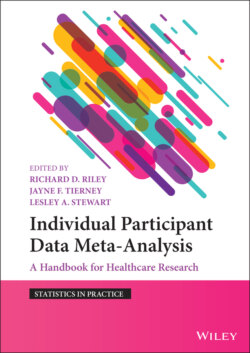Читать книгу Individual Participant Data Meta-Analysis - Группа авторов - Страница 77
4.2.6 Deciding Which Variables Are Needed in the IPD
ОглавлениеAs for all systematic reviews, the pre‐specified outcomes for the IPD meta‐analysis project should be those judged to be most important and relevant to the objectives, even if ultimately there are insufficient data available to analyse all of them. While consideration of the participant‐level variables required begins when the IPD meta‐analysis questions are formulated, this should be re‐visited before requesting IPD from trial investigators, so that they can be specified more precisely and ensure that the planned analyses can be completed satisfactorily. Trial publications can provide an initial guide as to which data might be available, but more variables may have been collected in a trial than is evident from a trial report. Often the trial protocol and the associated case report forms can provide a more reliable indication of which data have been recorded. Irrespective of whether these documents are available or not, it is useful to supply trial investigators with a provisional list of desired variables via a paper or online form, or as a detailed data dictionary (Section 4.2.7), so that trial teams can clarify precisely which data items they can provide. An example of the typical types of data requested from trial investigators is shown in Box 4.3.
In addition, it is important to anticipate what supplementary analyses might be needed in the IPD meta‐analysis project to explore the main results. For example, for a question about the effects of chemotherapy on long‐term cancer survival, it may be helpful to collect data which would allow the investigation of the effects of treatment on different (competing) causes of death, such as those due to cancer, treatment‐related side effects or co‐morbid conditions.
In many cases, it will only be necessary to collect outcomes and participant characteristics as defined in the individual trials. However, additional variables might be required to provide greater granularity (e.g. sub‐scales in quality of life instruments), or to allow outcomes or other variables to be defined in a consistent way for each trial. For example, in an IPD meta‐analysis of anti‐platelet therapy for pre‐eclampsia in pregnancy, data on systolic and diastolic blood pressure plus presence of proteinurea were collected. This was to allow the central research team to analyse pre‐eclampsia according to both a pre‐defined meta‐analysis definition, as well as the individual trial definitions (of which there were many variations).97 Furthermore, if the IPD are to be maintained in perpetuity, to address new questions that might arise, additional data may be requested to effectively ‘future‐proof’ the database. For example, if there is a plan to use the IPD collected to produce conditional treatment effects (Chapter 5), to identify predictors of treatment effect (Chapter 7), or to identify prognostic factors (Chapter 16), then it would be sensible to request more detailed baseline data than might be necessary if just the overall (unadjusted) effects of treatments were of interest. Having said that, it is important to avoid collecting extraneous data, as these will still need to be checked and managed, and if not used, this represents an unnecessary burden for the trial teams who have spent time preparing data. Of course, it may be easier for trial teams to provide a complete trial data file, and let the IPD meta‐analysis research team extract what they need.
